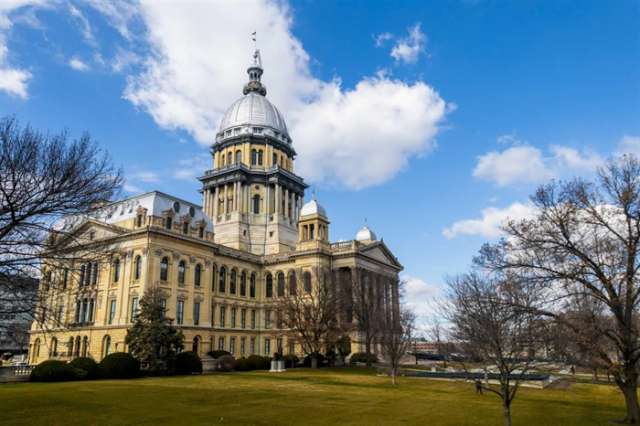
Nearly 9 in 10 State-Level Primaries Give Voters No Choice in Candidates

Published on March 4 2024 3:22 pm
Last Updated on March 4 2024 3:30 pm
The exterior of the Illinois State Capitol is pictured in Springfield. In 2024, nearly 90 percent of Statehouse primaries feature either one candidate or none at all. (Capitol News Illinois photo by Andrew Adams)
By ANDREW ADAMS
Capitol News Illinois
aadams@capitolnewsillinois.com
On March 19, voting will conclude in primary contests for hundreds of seats in the Illinois legislature and in the state’s court system. But most of those contests are uncompetitive.
Statewide, 88 percent of judicial and state legislative primaries feature either a single candidate or no one running at all. This is the highest number of uncompetitive primaries for those seats in at least 20 years, according to a Capitol News Illinois analysis of data going back to 2004.
The number of primaries with no candidates running at all is similar to years past, about 33 percent. But the number of primaries with a single person running has jumped to 55 percent, from 46 percent in 2020.
John Shaw, director of the Paul Simon Public Policy Institute, said Illinois’ primary participation mirrors a national trend and is partially stoked by growing political polarization and state redistricting practices. The state process for drawing legislative districts is a partisan one by law, meaning many districts have been drawn in a way that favors one party over the other.
While that’s made primaries increasingly important in districts that lean heavily in favor of one party over the other, it’s also helped reinforce a trend of parties choosing not to run candidates in districts that were not drawn in their favor.
“The only battle is the primary,” Shaw, a former congressional reporter, told Capitol News Illinois.
Shaw said the expectation of candidates to work across the aisle has decreased in recent decades, meaning that parties lean into ideology more.
“It is not good for governance when candidates run unopposed in a primary or general election,” Shaw said.
For about 65 percent of state legislative and judicial seats, only one party’s primary has any candidates running, with most of those primaries featuring a single candidate.
While many of those races will likely be uncompetitive in the general election as well, the number of contested seats could grow beyond what the primaries indicate via a political appointment process. The political parties have until June 3 to select a person to run on the party’s behalf in races where the primaries did not produce a winning candidate. That person would be chosen by local party officials, such as county board chairs in downstate Illinois or ward committees in Chicago.
“It’s not routine, but it’s not unheard of,” Illinois Board of Elections spokesperson Matt Dieterich said of the process.
Long-term trends
John Jackson, a professor at the Paul Simon Institute, said the stark divisions in party control are driven by party realignment and polarization, which have resulted in fewer candidates running on politically moderate platforms.
“That started nationally, then trickled down to state, even now to local,” he said.
Jackson, who works at an institute founded by and named for a conservative Democratic senator, noted this trend only emerged in the past few decades.
“There used to be moderates in the Republican party and moderates in the Democratic party,” Jackson said. “They were much more heterogeneous than they are.”
In Illinois, that’s led to stark partisan divides that also fall squarely along urban-rural lines. The city of Chicago remains the center of Democratic power in a democratically controlled state. Republicans have few primary candidates in the city and no serious challengers to most Democrats running.
Rural Illinois, meanwhile, remains almost unrepresented by the state’s Democratic party in the legislature or on the bench, with few Democratic candidates filing to run on rural primary ballots.
Only one legislative seat is competitive for both Democrats and Republicans: the 76th House District. This district contains most of the city of DeKalb as well as stretches of DeKalb, LaSalle and Bureau counties. The district’s current representative – Rep. Lance Yednock, D-Ottawa – is not running for reelection, and two Republicans and three Democrats are vying to replace him.
The legislative primaries that have drawn the most candidates include two four-way Democratic contests in the Chicago area. The primary for the 20th Senate District in Chicago, a seat currently held by Sen. Natalie Toro, D-Chicago, is Toro’s first senate race. She was appointed to the seat last summer to fill out the remainder of former Sen. Cristina Pacione-Zayas’ term after she resigned to take a position with the city of Chicago.
In the House, the south suburban 79th District also features four Democrats vying for the seat. The district has been represented by a Republican since 2016 and is currently held by Rep. Jackie Haas, R-Kankakee.
The 53rd Senate District Republican primary also drew four candidates. That seat is currently held by Sen. Tom Bennett, R-Gibson City, who is not running for reelection. He was appointed to the seat early last year after serving in the state House.
Judicial elections getting more attention, low competition
While there are primaries for 82 judicial positions across the state, about 85 percent of them feature either one or no candidate on the ballot. Just over half feature a single candidate across both major party primaries.
Part of this is due to the high number of races in Cook County – a very Democratic area – which operates the second largest court system in the nation.
But the low number of interested candidates can be partially explained by shifting career goals among lawyers, according to Eizabeth Monkus, senior research attorney at the nonprofit judicial reform advocacy group Chicago Appleseed Center.
“People come into the profession with different goals than they used to,” Monkus said.
Monkus noted that there are more people interested in what she called “movement lawyering,” where a person furthers political and social goals through legal advocacy, rather than working as a trial lawyer or working on criminal cases.
“If you’re working to change the world, judges have less power to do that than you might expect,” Monkus said.
But judicial elections are important because of their impacts on a local – often personal – level, where Monkus said judges’ decisions can have a “long and lasting” impact.
Monkus noted that since she began working in judicial elections over a decade ago, people are more aware of judicial elections than they used to be, despite the relatively low number of candidates in any given race. She attributed that to increased voter interest, more campaigning in high-profile races and more thorough news coverage.
The most high-stakes judicial primary this year is the battle over one of the state’s Supreme Court seats from the 1st District in Cook County.
That race features Joy V. Cunningham running to keep the seat she was appointed to in 2022 against Jesse G. Reyes, an appellate court judge who also ran in 2020 in a heated seven-way primary for the seat currently held by P. Scott Neville. Reyes came in second in that race with 20.3 percent of the vote to Neville’s 26.2 percent.
As with most judicial races this year, it’s a one-party race at this point. No Republicans are currently running for the seat on the state’s highest court.
Capitol News Illinois is a nonprofit, nonpartisan news service covering state government. It is distributed to hundreds of print and broadcast outlets statewide. It is funded primarily by the Illinois Press Foundation and the Robert R. McCormick Foundation, along with major contributions from the Illinois Broadcasters Foundation and Southern Illinois Editorial Association.












